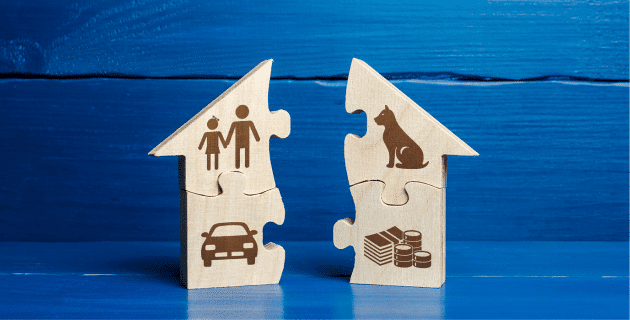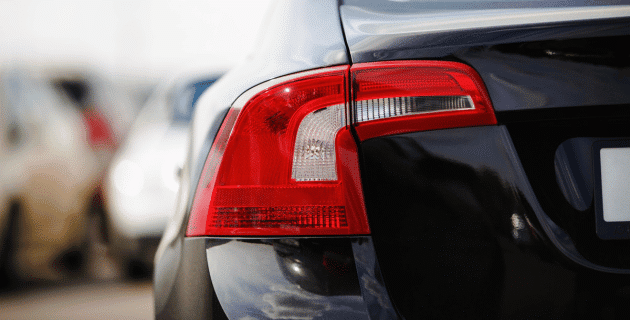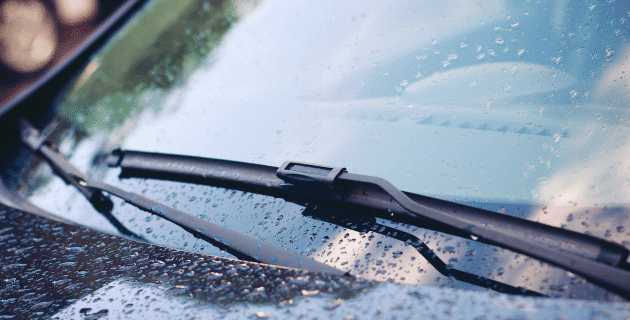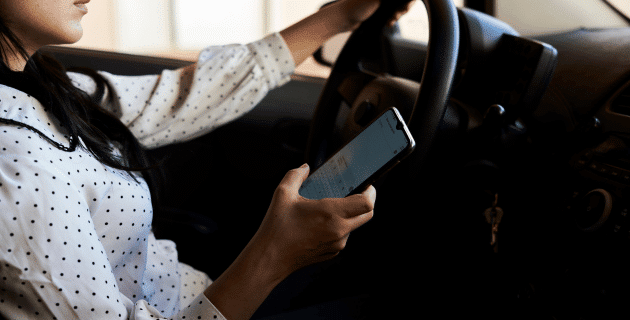
by California Casualty | Auto Insurance Info, Homeowners Insurance Info |
When you’re married, you share insurance policies with your spouse. When you’re separated or divorced, you need to make changes to all of your financial documents, including insurance.
You will want to contact your insurance company when a separation or divorce is beginning. Here’s a quick guide to navigating your auto and homeowner’s policies during this challenging time.
Auto Insurance
Where you live will determine whether you can stay on the same car insurance policy while separated.
-
- If you’re at the same address, and that’s where your cars are parked at night, then you can keep the car insurance together for the time being.
- Make sure your insurer has both spouses’ contact information. However, note that any correspondence, such as a copy of nonpayment information and a legal notice, will only be sent to the address on the policy.
- If you have different addresses, because you are separated, that’s the time to get separate policies. As a side note, even if you are married and you keep the car at separate addresses, you may need separate policies. Your insurer sometimes can add a separate “garaging location” but you do need to notify the insurance company whenever addresses and vehicle locations change.
When you divorce, you will need individual car insurance policies.
-
- That may mean that one person takes over the current policy and the other gets a new one, or you both get new ones and the original policy is canceled. There may be cancellation fees involved.
- If both spouses are residing in the same household, both are still named insureds and only one person’s authorization is needed to cancel or change a policy. Once the ex is removed, the ex no longer has any input into what the insured does with the policy.
- If you share ownership of a car, you will need to get that car titled in one person’s name. You may need to revisit financing options as well if it is still being paid off.
- Make sure you get the new policy before you cancel the old, or you could be penalized for a gap in coverage.
There may be a difference in price with the new policies.
-
- Don’t be surprised if your rate goes up or down after divorce, even if you took over the original policy. For example, you will likely lose the discount given for being married. You may lose a multi-car or multi-policy discount. However, if your spouse’s driving record is worse than yours, your rate as a single person may be lower than it was as a couple.
- Refinancing a house or buying a new car also can change your credit score, which is used to determine your rate.
- Your new zip code will likely change the amount that you need to pay. Location is often factored into the insurance rate whether auto or home.
Teen drivers have to be included on the policy.
-
- The car that your teen drives can only go on one policy. You will need to pick who is responsible for paying the insurance and that is where the teen/car will be rated.
- If your son or daughter lives mostly at one location, your teen may be listed on the policy at that home.
- While insurers list everyone age 14+ on the policy, they only charge a premium if the teen is not insured elsewhere. They don’t want to double insure any person or car.
-
- If your son or daughter regularly parks his or her car at both parents’ homes, your teen will still be covered at both locations.
- Your divorce agreement can determine if your spouse contributes to the payment of the policy that covers your teen.
Homeowner’s Insurance
A homeowner’s policy can be maintained during a separation, but should be changed as soon as the divorce is finalized. At California Casualty, we typically wait until the divorce is final and/or the policy renewal date to move property policies from one account to another.
-
- Only a named insured on the policy is authorized to make changes. Ideally, the changes should follow the separation agreement.
- The effective date the change takes place depends upon your policy.
- The spouse who moves out, but is still on the deed, should be named as an additional insured.
You will want to get renter’s insurance if you are moving out of your house.
-
- Renter’s insurance is like homeowner’s insurance but for tenants. Starting at about $10 a month, it protects your personal belongings.
- It will include personal liability coverage, an important safeguard if you’re found at fault for property damage or injuries at your place (and even around the world).
- It also can help if your apartment or home is unlivable, due to a covered loss. Insurance can cover the increase in living expenses.
Your homeowner’s policy should be listed under whoever keeps the house.
-
- If one spouse gets the house in the divorce, the homeowner’s policy must be transferred to their name.
- Your insurer will rewrite the policy based on updated personal property coverage and the current needs of the homeowner. Any umbrella policies should be reviewed.
- Ask for ways to keep your rates affordable, such as bundling home and auto, or buying a home security system.
- Ask about discounts, too. California Casualty offers discounts to nurses, educators, and first responders.
This article is furnished by California Casualty, providing auto and home insurance to educators, law enforcement officers, firefighters, and nurses. Get a quote at 1.866.704.8614 or www.calcas.com.

by California Casualty | Auto Insurance Info |
You don’t have to wait for your auto policy to expire to change insurance companies. However, you do need to make sure you’re fully covered without any gaps in insurance. We’ve compiled some guidelines to help you decide if a change is right for you.
When should you think about changing policies?
While you don’t need a reason to change your auto insurance, there are some times when it makes sense for you to revisit your policy—even if you don’t change insurance companies. You may end up modifying your current policy to meet your evolving needs. For example:
-
- If you’ve had a major life change, such as getting married or divorced, you may need more or less insurance.
- If you’ve moved to a new zip code or state, the new location could affect your premium.
- If you’ve become a homeowner, you can bundle your auto and home and save money.
- If you’ve gone from working out of the home to remote work, your annual mileage may be less.
- If you’ve bought a new car, you will want to check insurance policy options.
- If your teenager is about to get his or her license, that will add to your policy.
- If your credit score has improved, you may qualify for a lower rate.
- If you’re unhappy with your current insurer, you can consider a change.
- If you’re approaching your renewal date, you can terminate a contract without cancellation fees.
Follow these steps to make the change.
Step 1: Consider your coverage options.
Figure out how much coverage you need. If you depend upon your care, you want to make sure that you have enough to replace it if necessary. Also, check your state laws. Some states will require you to have certain car insurance. If you lease or finance a car, your lender or lessor will require you to purchase collision and comprehensive insurance.
Step 2: Compare quotes from multiple insurers.
Get quotes from several insurers, and make sure you are comparing the same coverage, limits and deductibles. Sometimes policies are cheaper because they don’t have the same coverage. This is also a good time to contact your current insurer to find out about discounts, or other ways to lower your cost. California Casualty offers discounts to nurses, educators, and first responders.
Step 3: Check for penalties and perks.
If you’re in the middle of your policy contract, there may be a penalty for canceling. Make sure you figure that into the decision to switch. You also will want to look for the perks, or little extras, that are offered. Some insurers offer inexpensive roadside assistance or accident forgiveness for qualified customers. Some have smartphone apps or are available 24/7 online.
Step 4: Do your research.
You want to know how your new insurer handles claims, and whether they have a good customer service rating. It may not be worth a lower price if it’s going to be a hassle dealing with the new company. Check out your insurer with the Better Business Bureau, JD Power, or the National Association of Insurance Commissioners.
Step 5: Make sure there’s no gap in coverage.
Car insurance lapses can be expensive, especially if you have an accident on the day in between. If you cancel one policy, make sure the other one is already in place. Your new insurance company can provide proof of insurance to your old company. However, they cannot cancel your policy. You need to do so. You’ll receive a refund for any unused portion. There may be a cancellation fee.
Pro Tip: Also remember to cancel automatic payments to your old insurer with your bank or credit card.
Step 6: Notify your insurer and lender.
Make sure to officially cancel your policy with your old insurer. Otherwise, your insurer will think you simply stopped paying your bill, and you could be liable for charges. Some insurers require 24 hours before canceling, so make sure you are aware of the terms. Also let your lender or lessor know about your new insurance if you are leasing or financing your car.
Step 7: Replace your insurance ID.
Once you make the change, ask for a digital copy of your insurance card. You can also order a printed card. Remember to place your new insurance card in your car’s glovebox.
Finally, if you have an open claim, wait to make a change.
You may not be able to change insurers if you have an open claim with your current insurance company. The claim has to be paid and closed. Also, the rate quoted from your new insurance company may not take into account that most recent claim. If that’s the case, you could have a big increase when you renew with the new company, or even be responsible for a retroactive fee.
Get started with a free quote today at mycalcas.com/quote.
This article is furnished by California Casualty, providing auto and home insurance to educators, law enforcement officers, firefighters, and nurses. Get a quote at 1.866.704.8614 or www.calcas.com.

by California Casualty | Auto Insurance Info |
If your windshield wipers are leaving long streaks and making loud squeaks, they’re trying to tell you something. They’re ready to be replaced.
Your wipers are not meant to last forever. The rubbery blade wears down over time. Squeaks, streaks, and smears happen when the blades don’t make proper contact with the glass. That causes dangerous driving conditions and potential accidents when you can’t see clearly through your windshield.
You generally have to replace your wiper blades every 6-12 months. Look for these signs that your blades are ready for replacement:
• Worn edges
• Cracks, tears, and missing pieces
• Stiffness in the rubbery part (inability to flex)
• Squeaking or chattering
• Streaks on your windshield
If your wipers are leaving streaks but not making sounds, you can clean the blades, which are the rubbery part of your wiper. Dip a rag or paper towel into rubbing alcohol. Wipe it along the blades, and the windshield. This can help extend the life of your blades for another month or two before you have to replace them.
How to replace your wipers
Step #1: Get the right wipers for your vehicle.
Windshield wiper blades come in many different sizes so it’s important to get the right ones. Your vehicle may even use two different lengths of front wiper blades. (Don’t forget your rear one, too.) One way to find the right size(s) is read your car’s manual. You also can go to an auto parts store in person or online to get assistance. The online sites will often have you type in your car’s make and model.
Once you find the right size, you’ll have other choices to make. Conventional and synthetic rubber blades are usually the cheapest. They will break down over time with exposure to the sun’s UV rays. If you are looking for longer-lasting blades, consider silicone, which is more expensive. There are options for sturdy winter wipers, flat blades, and hybrid blades, too. The difference is that with the conventional kind, you can replace just the rubbery blade. With the others, you have to replace the whole piece.
Many national auto parts stores will install the wipers that you just bought there, sometimes for no additional charge.
Step #2: Get the wipers in position.
You’re ready to start the replacement. Turn the car on and give your windshield a squirt of wiper fluid to lubricate it. Then, turn on the wipers just so you can get them into position. When the two blades are pointed upward toward your roof, turn your car off. Get out of your car and pull the wipers forward so they’re standing upright at 90 degrees.
Step #3: Place a towel on the glass.
Wiper blades are spring-loaded. That means that they can snap back against the windshield. Once you expose the metal wiper arm, this could result in a cracked windshield. To protect against that, cover your windshield with towels. Alternatively, you could wrap the metal hook of the wiper arms with a rag once you detach the blades.
Step #4: Detach the blades.
There are two basic types of traditional wiper connections: tab and pin type. There is a slightly different installation process for each type.
Look for the spot on the wiper where the blade attaches to the arm. There may be a tab where the blade connects. If you don’t have a tab, you may have a pin-type connector. If in doubt, check your vehicle’s user manual for blade removal steps.
• For tab connectors, use your finger to push the tab outwards or inwards. As you push, grab the blade and pull it down parallel to the arm. You should be able to pull it all the way out. You may need to tug a bit if there’s built-up debris.
• For pin-type connectors, you will need to pull the tab up, and pull the pin out. Use a small flathead screwdriver to lift the connecting pin. You should then be able to slide the blade off.
Step #5: Install the new blades.
Remove the new blades from their packaging and then proceed depending upon the type of connection.
• For tab connectors, look for a tab suspended in the middle of a long rectangular hole. Slide the arm hook up and over the tab. Pull the blade up until you hear a snap.
• For pin-type connectors, look at the new blade and look for a small hole in the body. Pull the black tab up slightly. Align the hole with the pin on the wiper and it will snap into place.
Step #6: Clean the windshield.
You’ve got new wipers so you’ll want to make sure your windshield is clean, too. Lift the blades up so they are off of the windshield. Use automotive glass cleaner, a clean and dry microfiber cloth, and a little elbow grease. Alternatively, you can use water, dishwashing liquid, and a few drops of vinegar. Dry your windshield with a clean microfiber cloth. Put your blades back down and you’re ready to go.
If you just want to replace the rubber inserts
You can replace the entire windshield wiper assembly (as described above) or you can simply buy new blade inserts if they are available for your vehicle. This can save you money; however, it is a bit more complicated to replace just the rubber and may require tools. Consult your car’s manual for details.
Replacing wiper blades is part of good car maintenance. And as always, don’t forget to protect your vehicle with the right insurance for added peace of mind.
This article is furnished by California Casualty, providing auto and home insurance to educators, law enforcement officers, firefighters, and nurses. Get a quote at 1.866.704.8614 or www.calcas.com.

by California Casualty | Auto Insurance Info, Finances, Homeowners Insurance Info |
It may not seem like a big deal, but forgetting to make an auto or home insurance payment or having a lapse in coverage can have serious repercussions.
Let’s say you don’t drive that much anymore, so you miss an insurance payment or two, but then you get into an accident… If your premium goes unpaid, your insurance policy is void. Meaning, your insurance company is not obligated to rewrite your policy. You’ll be left without coverage and will likely have a higher rate when you do find a new carrier because the lapse has now left you labeled as “high risk”.
Your cancel notice gives you the date that payment must be received by, and if that date occurs with no payment, the system will automatically cancel your policy. Once you’re canceled, your carrier will not take you back unless they are required by law.
Let’s dive further into more facts and answer some questions every vehicle or homeowner should know about their coverage.
Home insurance is required if you have a mortgage.
While home insurance isn’t required by law, your lender will require you to be insured if you have a mortgage. Your policy will need to cover wind, hail, fire, and vandalism. The lender will be named as an additional insured. Should you file a claim for damage or loss, the insurance company will issue a two-party check naming you as the insured along with the mortgage company.
If you fail to pay your home insurance, you could have a lapse in coverage. Your policy will cancel, which is a violation of your mortgage agreement, and there will be no coverage in the event of a loss or claim. Also, the homeowner’s insurance is a package, which covers the home, other structures, your personal property, additional living expenses, and provides personal liability. You will lose all of that if the policy cancels.
Car insurance is required by law.
In every state except New Hampshire, you’re required to have car insurance. You have to have minimum coverage in case you get in an accident, though what you are required to carry does vary by state.
When you register your car, you submit proof of insurance. When you buy a car, you can’t leave the lot without signing up for insurance. It’s just along the way that you might accidentally, or on purpose, miss a payment and cause your insurance to lapse.
What is a lapse?
You pay for a specific time period on your insurance. It may be six months, a year, or another timeframe. In all cases, you will have a start date and an end date. As long as you are paying the bills on time, all is well.
If, however, you miss a payment, your coverage lapses. A lapse in coverage can be as short as one day or it can be much longer. Like other bills that you may be late in paying, there may be a grace period and a late fee. Unlike other services, however, you might face more severe consequences including government-mandated ones, if the lapse goes too long.
What happens when you drive without insurance?
If your insurance premium goes unpaid for long enough, your insurer will cancel your policy. Insurance helps with the financial responsibility if you get into an accident. Because it is usually required by law, there are additional consequences if you don’t have it. Here’s a summary of what you can expect if you let your insurance lapse.
-
- If you’re in an accident, you would be fully responsible for any damages or injuries.
- Depending upon the state where you live, you may be limited in the amount that you can sue the at-fault driver.
- Your insurance company may cancel your policy and alert the Division of Motor Vehicles.
- Your license and registration may be revoked, and you would be responsible for paying daily fines to the Division of Motor Vehicles. You may also have to pay a fine to reinstate your license and registration.
- Once you are reinsured, you may need to carry an SR-22 form with you for three years, showing proof that you have the minimum required insurance.
- You may have difficulty getting insurance again, as you’re now considered a risk. If you do get insurance, your insurer can raise your rates. Drivers with a coverage lapse of 30 days or more saw an average premium increase of 35%.
- Your car could be repossessed if it is leased or if you are paying a loan.
- Your credit score may drop, which can affect your ability to get a loan or credit card. The lapse will remain on your credit report for up to 7 years.
What happens if your home insurance is canceled?
If you lapse in payments for your home insurance, and as a result, your policy is canceled, your mortgage lender will be informed in writing.
-
- Your lender can force you into a more expensive policy, called forced-placed insurance. This insurance only covers the loan amount for the mortgage company. There is no coverage for your belongings or personal liability. Therefore, if the house costs more to rebuild than the remaining loan amount, it won’t be covered.
- If you don’t agree to the insurance, your lender can send your loan into default. This presents a risk of losing your home to foreclosure.
- Your credit score will drop as a result.
- Without insurance, whether or not you have a mortgage, you are responsible for 100% of the costs for any damage to your home if something unexpected happens.
What should you do if you have a lapse in coverage?
-
- Once you realize your policy has been canceled or you’ve missed a payment call your insurance company and see what can be done.
- Find out if they are able to rewrite your policy. Pay whatever fines are needed. Many companies may charge extra or interest fees on the remaining balance but California Casualty only charges a small monthly fee.
- If you cancel over a certain number of days, you will be looked at as a brand-new customer and have to meet all underwriting guidelines. You may lose certain discounts or benefits for customer loyalty.
- If you’re unable to make your insurance payment, let your insurer know. They may be able to adjust the policy to lower your cost.
- Your insurer may deny you coverage. In that case, you will need to shop around for a new policy. Be honest with the new company. They will be able to check to see if your coverage has lapsed in the past. Be prepared to pay a higher premium because of it.
- After you get insurance again, contact your state’s Division of Motor Vehicles to update your insurance information. Make sure that your registration and license are still valid.
- Similarly, update your mortgage lender if your home insurance has been affected.
- If you’ve changed insurance companies, and you owe your old insurance company any money, make sure to pay it. They will likely pass it along to a debt collection agency if you do not.
How can you prevent a lapse?
The best way to avoid any lapse in coverage is to set up a system so you will pay your premium
on time.
-
- Pay the premium in full if you are able to do so. Consider using your credit card for your annual insurance payment to get extra credit card award points. There is a cost savings and convenience of paying in full with most policies. At California Casualty, if the state allows, both auto and home policies offer this type of savings.
- Set up automatic payments such as an EFT from your checking account or a payroll deduction, if offered or available.
- Set a reminder on your phone or calendar for your premium due date.
- Make sure you know the end date of your policy. From 30-60 days prior to the renewal, California Casualty sends out a renewal policy for the insured to review. Schedule a time with an agent to review your policy to see if you need any updates before the renewal takes place.
- If you switch insurance companies, make sure to time the start date of your new policy with the end date of your old policy so there is no lapse.
- Talk to your insurer about options if you are not driving for an extended period of time. For example, you may be deployed overseas. You still may want coverage since your car would remain at risk for damage due to weather or vandalism, and it could be stolen. However, you can suspend coverage for a time period, including while you are deployed or on sabbatical. This may not be an option if your car is leased or you’re paying off a loan.
This article is furnished by California Casualty, providing auto and home insurance to educators, law enforcement officers, firefighters, and nurses. Get a quote at 1.866.704.8614 or www.calcas.com.

by California Casualty | Auto Insurance Info, Safety |
We all want to think that we’re good drivers. The truth of the matter is, every once in a while, we get distracted…some of us more than others. We reach for that French fry. We have an argument with the kids in the backseat. We hear our phone ding and instinctually grab it to look at a message. We know better, but we do it anyway.
In honor of April, Distracted Driving Awareness Month, here’s a reminder about the dangers of distracted driving and why it’s important to stay focused behind the wheel.
Distracted driving by the numbers
Nine people die each day in crashes caused by distracted driving, reported the Centers for Disease Control (CDC). Over 3,100 people were killed and 424,000 injured due to distracted driving in 2019. One in five who died weren’t even in a vehicle. They were walking, riding their bikes, or simply at the wrong place at the wrong time.
Distracted driving deaths have increased by 12% from 2020 to 2021, reported the National Highway Traffic Safety Administration (NHTSA). Drivers aged 18 to 34 are more likely to die due to distracted driving than any other age group. It’s no surprise that teens, with their inexperience behind the wheel and the world at their fingertips, are at greater risk for distracted driving. A survey of U.S. high school students found that 39% admitted to texting while driving in the past 30 days.
What is distracted driving?
Distracted driving is defined as any activity that takes focus off of the road. There are three major types of distractions, as defined by the CDC:
- Manual: This causes you to take your hands off of the wheel, such as when you are reaching for something. If you’re eating while still looking at the road, that could be a manual distraction.
- Visual: This is anything that takes your eyes off the road ahead. If you are rubbernecking, fiddling with the radio, or even looking at your GPS, that could be a visual distraction.
- Cognitive: This type of distraction takes your mind off driving. If you are texting or emailing while driving, that’s a cognitive distraction. If you’re engaged in conversation, daydreaming, or worrying, that takes your attention away, too.
Reaction time and distracted driving
You may think that glancing at your phone to read a text is no big deal, and takes no time at all. Consider this. If you’re reading a text while driving 55 mph, you’ll probably take your eyes off the road for 5 seconds. According to NHTSA, that’s like driving the length of a football field with your eyes closed. Five seconds is more than enough time to whiz past a stop sign, slam into a car that suddenly brakes in front of you, or seriously hurt or kill a pedestrian. Texting while driving increase your chances of crashing by 2300%.
Even hands-free devices can be a mental distraction. An AAA study found that it takes 27 seconds to regain your full attention after engaging with your hands-free device. At 25 mph, that’s enough time to travel nearly three football fields.
How distracted driving affects your insurance
Many states have bans for handheld cell phones while driving. It is your responsibility to know the local laws, even if you’re traveling out of state. If your state has banned cell phone use, even holding your phone at a stoplight can get you a ticket. If the engine is turned on, your car is considered in motion.
Tickets for illegal cell phone use can come with hefty insurance penalties. Forbes noted that if you are found to be distracted driving, it could raise your insurance rates as much as 41% depending on the state where you live. The average is an increase of 16%. So, in addition to the damage that distracted driving can do to people and property, it can affect your wallet, too.
Tips to stay focused
Follow these tips to keep your eyes on the road, your hands on the wheel, and your mind on driving.
-
- Avoid multitasking while driving. Do everything you need before you start the car. Set up the GPS. Choose radio presets. Send any texts you need to send before you start the car.
-
- Leave your phone in a secure place. Enable the “do not disturb” setting while you’re driving. Your phone will silence texts and maybe even send an automatic response text that tells people you’ll reply to them when you’re not driving.
-
- When in doubt, pull over. Find a parking spot or lot to enter an address in a GPS or call or text someone. Plan breaks to eat, text, and talk.
-
- Lead by example. If you have teens or pre-teens, they are watching your driving habits and taking note.
-
- As a passenger, you can help the driver focus on the road. Limit distractions around them, and speak up if you see them starting to text or otherwise shift their attention.
-
- Educate yourself and your loved ones on the dangers of distracted driving.
Safe travels.
This article is furnished by California Casualty, providing auto and home insurance to educators, law enforcement officers, firefighters, and nurses. Get a quote at 1.866.704.8614 or www.calcas.com.

by California Casualty | Auto Insurance Info |
Maybe you work from home or you live close to work. Perhaps you regularly use rideshare services or public transportation. As a result, you drive less than most people. If that’s the case, you may qualify for the lower rates.
Your annual mileage is a factor in determining your insurance rate. After all, if you drive less often, you have a reduced chance of getting into an accident. There’s also less wear and tear on your car so it stays in better shape. That’s why insurance companies offer discounts for low-mileage drivers.
Low Mileage Discounts
The average American drives about 13,476 miles a year or 37 miles a day. Low mileage insurance policies generally apply to those who drive about half of that amount or less. Each insurer sets its low mileage number so check with your insurance company to see if you qualify.
Your premium may be reduced by a percentage because you are a low-mileage driver, but how do they get this information if you don’t tell them? Your insurer may order reports from a third-party verified mileage program to get your annual mileage data. That data will be used when renewing your policy to make sure the insurer is using the most accurate vehicle information.
Low mileage discounts are automatic. When the mileage is determined, the rate factor (which can result in a decrease or increase) is automatically applied.
How to Reduce Your Mileage
You may be able to reduce your mileage to qualify for a low mileage discount. Here’s how.
-
- Start by calculating your mileage. Write down the odometer reading at the beginning of the week with the date. Then, check it after one week to find out how many miles you traveled. Multiply that number by 52 to get an estimate of about how much you drive a year.
-
- Commuting to work is the number one way that people rack up miles. If you do have a commute, investigate the ways that you can reduce the miles you drive. Try carpooling with a colleague. See if public transportation is available. Ask your employer if you’re able to work from home for a portion of your time.
-
- Plan ahead when doing errands. Map out where you need to be and group your stops. If your grocery store is on your way home from work, for example, plan to stop en route rather than making an extra trip. Pro Tip: Choose free or low-cost home delivery services to avoid the time on the road altogether.
-
- Walk or bike when you can, instead of driving. It gives you the benefit of great exercise in addition to saving on your car’s mileage. Just make sure to brush up on bicycle safety. Pro Tip: Use bike-share programs if your area offers them to save on the cost of a bicycle.
-
- If your family has two cars, try using one for daily driving and the other for leisure. In this way, you may qualify for a low mileage policy on the vehicle used less often.
Your car is one of your greatest investments. Keep it well-maintained and protect it with the right insurance.
This article is furnished by California Casualty, providing auto and home insurance to educators, law enforcement officers, firefighters, and nurses. Get a quote at 1.866.704.8614 or www.calcas.com.






